(Or Loving My Mental Health Class During Summer School Because We Talk About LGBTQIA+ Community and their Rights to a HEALTHY, NON-DISCRIMINATED LIFE as Human Beings)
By Eddlynn Jennifer Mangaoang
Written on June 23, 2021
Please do not repost or copy to another site. Thank you. Enjoy reading. Discussions are encouraged.
June is the PRIDE Month. It honors the Stonewall Uprising on June 28, 1969, in Manhattan as a response to a police raid and violence that occurred in the early morning (1). Police raids of gay or LGBT bars are quite common in the 1960s because the State Liquor Authority (SLA) refuses to issue liquor licenses to gay bars using anti-gay values as a reason (2). Since then, the Pride Movement expands, and the LGBTQ communities become organized activist groups that use their voices to fight for their human rights.
However, in the 1980s, the LGBTQ+ communities, especially the gay communities, once again face another obstacle - HIV/AIDS (3). Because the Human Immunodeficiency Virus (HIV) first shows up around the gay community at that time, there is a notion that it is a gay virus, and the stigma that comes with that label becomes another setback for the community. There is much research about HIV and Autoimmune Deficiency Syndrome (AIDS) for the past 3 to 4 decades that the disease becomes a chronic illness instead of an acute one, but because of the misconceptions of uneducated individuals, there are still people who think you can only get the virus through gay sex. HIV/AIDS is transmittable through bodily fluids, except saliva, and it does NOT discriminate (4).
No matter what the reasons are, the bullying of the LGBTQIA+ community among puberty and adolescence still occurs to this day. Bullying includes physical and verbal harassment and attacks. Using slurs like "faggot" and "dyke" or isolating LGBTQIA+ teens and showing anti-gay attitudes and behaviors toward them in school gives the impression that no one cares about them (5). LGBTQIA+ teens are more likely to show health risk behaviors such as alcohol and substance abuse, sexual risk-taking, and mental health issues and carry those to adulthood (6).
According to an article (7) I've read for my Public Service Announcement (PSA) project, "84.6% of LGBT students reported being verbally harassed, 40.1% reported being physically assaulted at school." The safety of our LGBTQIA+ youth is in jeopardy because of bullying, but if even they feel like they couldn't talk to their family about their situation because of fear of unacceptance, our youth will become engulfed with mental illness, varying from anxiety to chronic depression, all might lead to a suicide attempt.
To prevent our LGBTQIA+ youth from developing health risk behaviors, we should (8):
1. Create rules and regulations of anti-bullying which focuses on the LGBTQIA+ students.
2. Teachers and other school personnel should receive training and professional development learning about how to diffuse and intervene during homophobic events inside the school, learn how to become open-minded, unprejudiced, and unbiased.
3. Start a Gay-Straight Alliance club or groups in school, and make sure to work on different projects that uplift the LGBTQIA+ teens and encourage other non-LGBTQIA+ students, teachers, school staff, etc., to participate and learn about the community.
4. Include LGBTQIA+ models or issues in the curricula and try to reach out for speakers who can lecture or share knowledge about LGBTQIA+, mental health, and anti-bullying.
5. Parents, teachers, and older adults need to learn how to talk to their LGBTQIA+ teens without putting them on the spot, without making them feel bad about themselves while showing them the respect they deserve.
References:
(1): Library of Congress: Lesbian, Gay, Bisexual, Transgender and Queer Pride Month: About Page: https://www.loc.gov/lgbt-pride-month/about/).
(2): PBS: American Experience: Stonewall Uprising | Article: Why Did the Mafia Own the Bar? https://www.pbs.org/wgbh/americanexperience/features/stonewall-why-did-mafia-own-bar/
(3) HIV.gov: A Timeline of HIV and AIDS: https://www.hiv.gov/hiv-basics/overview/history/hiv-and-aids-timeline
(4) Centers of Disease Control and Prevention (CDC): HIV Basics: https://www.cdc.gov/hiv/basics/index.html
(5), (6), (7), (8): stopbullying.gov: White House Conference Materials: Bullying & Lesbian, Gay, Bisexual, Transgender, Questioning (LGBTQ) Community by Dorothy L. Espelage, University of Illinois, Urbana-Champaign (2017), page 64: https://www.stopbullying.gov/sites/default/files/2017-09/white_house_conference_materials.pdf
(9) The Trevor Project: About page: https://www.thetrevorproject.org/about/
Resource:
National LGBTQIA+ Health Education Center: https://www.lgbtqiahealtheducation.org/


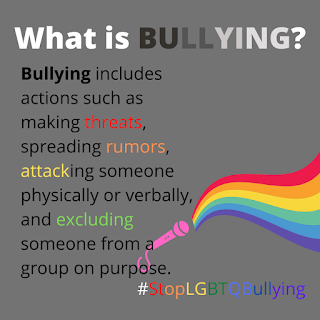
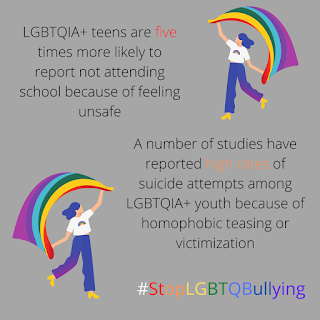
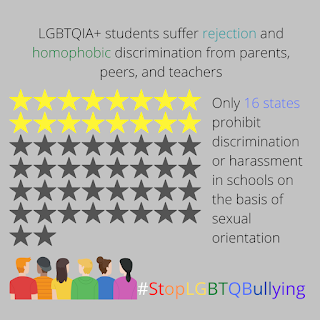
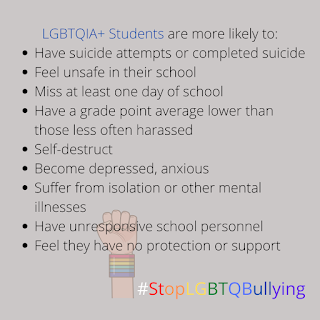
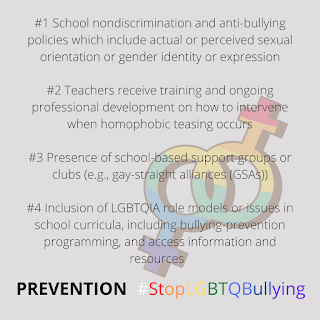


No comments:
Post a Comment